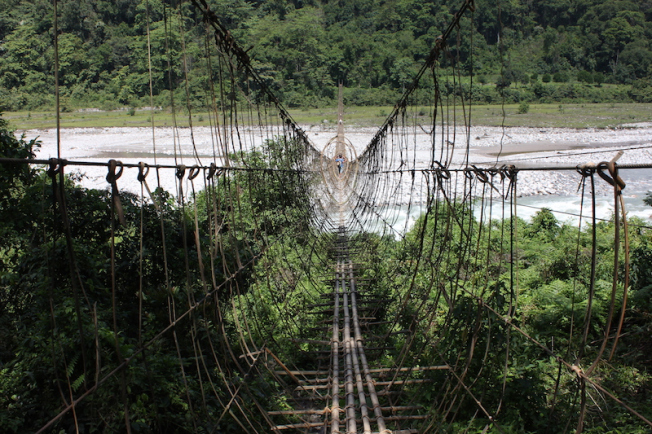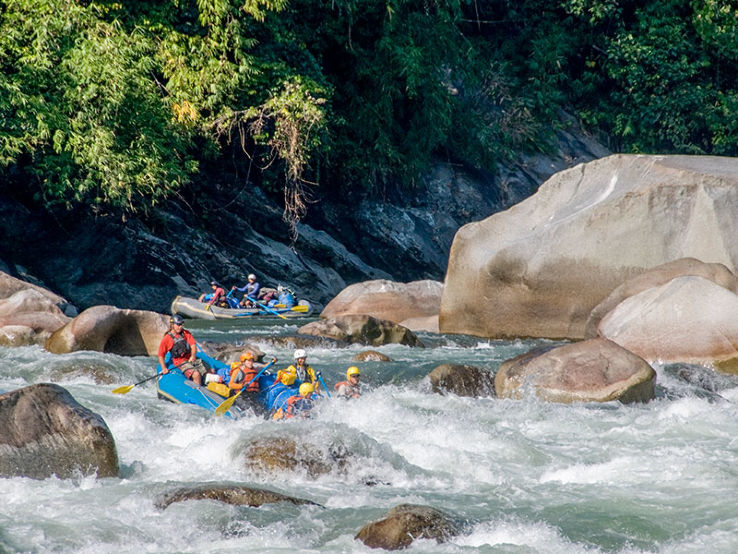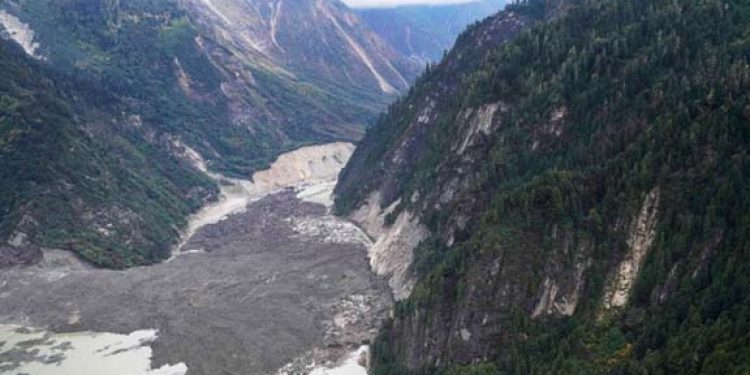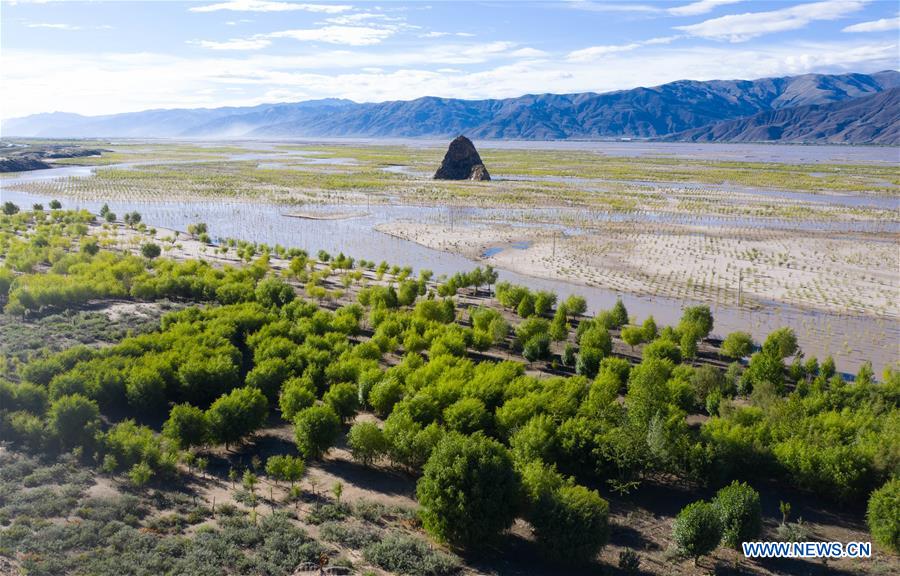August 2019
The Reducing Emissions from Deforestation and Forest Degradation (REDD+) programme being carried out in the himalayan states jointly by Indian Council of Forestry Research and Education (ICFRE) and International Centre for Integrated Mountain Development (ICIMOD) has been extended till July 2020.
ICFRE-ICIMOD’s REDD+ Himalaya: Developing and using experience in implementing REDD+ in the Himalaya programme was launched in January 2016 in Mizoram to addresse the drivers of deforestation and forest degradation in India’s Himalayan states.
While the initiative was meant to last only till 2018, it was on August 26, 2019, “extended till July 2020 keeping in view of the contributions made” by the agencies, RS Rawat, scientist in-charge biodiversity and climate change division, ICFRE told Down to Earth in an e-mail.
“The project was aimed at capacity building. We found that people’s major dependence on forest was for fuelwood, so we tried giving the people wooden stoves with better fuel efficiency. We also created alternative sources of income through planting bamboo, share coffee plantation,” said VRS Rawat, advisor ICFRE, who was involved with the process.
“People grow turmeric in the area and to process it, they use fire to dry it. We provided a village with solar drier for this process to reduce the demand for fuelwood,” Rawat added.
The project is supported by the environment, nature conservation and nuclear safety ministry of Germany, was implemented in four countries of the Hindu Kush Himalayan region— Bhutan, India, Myanmar and Nepal.
The REDD+ programme was initiated by the United Nations in 2005 to mitigate climate change through enhanced forest management in developing countries. It aimed to create incentives for communities so that they stop forest degrading practices.
More than 300 REDD+ initiatives have taken place since 2006. The mechanism is enshrined in the 2015 Paris Agreement and its implementation transitions from smaller, isolated projects to larger, jurisdictional programmes with support from bilateral and multilateral agencies.
By Ishan Kukreti
Arunachal Pradesh on Thursday received an amount of Rs 1588.72 crore under the Compensatory Afforestation Fund Management and Planning Authority (CAMPA), which is a major boost towards promoting afforestation and achieving green objectives.
Tripura and Mizoram received funds of Rs 183.65 crore and Rs 212.98 crore under CAMPA.
In total, union minister of environment, forest and climate change Prakash Javadekar handed over Rs. 47,436 crore of CAMPA fund to various States in the presence of Union Minister of State Babul Supriyo.
The fund shall be utilized as per the provisions of the Compensatory (Afforestation) Fund (CAF) Act and CAF Rules.
Speaking at the meeting, Union Environment Minister Javadekar said, “The State budget for forests shall remain unaffected, and the fund being transferred would be in addition to the State Budget.”
“It is expected that all States will utilize this fund towards forestry activities to achieve the objectives of the Nationally-Determined Contributions (NDCs) of increasing its forest and tree cover, which will create an additional carbon sink equivalent to 2.5 to 3 billion tonnes of carbon dioxide by 2030,” said Javadekar.
The Environment Minister further emphasized that CAMPA funds cannot be used for payment of salary, travelling allowances, medical expenses, among other expenses.
Javadekar highlighted the efforts of the government towards preserving and improving the forest wealth and ecological security of the country.
He said important activities on which the fund will be utilised will be for the Compensatory Afforestation, Catchment Area Treatment, Wildlife Management, Assisted Natural Regeneration and Forest Fire Prevention and Control Operations and others.
Besides, the other activities include soil and moisture conservation works in the forest, Improvement of Wildlife Habitat, Management of Biological Diversity and Biological Resources, Research in Forestry and Monitoring of CAMPA works.
- Firms that won the contract to set up the projects lack the capacity to do so, says govt
- india has installed generation capacity of 357.87GW. Of this, 45.4GW comes from hydropower projects
As many as 103 private hydropower projects in Arunachal Pradesh totalling about 35 gigawatts (GW) are still to take off despite the government’s Act East policy focus.
This comes against the backdrop of growing concerns on the delay in India’s plans to generate power from rivers originating from neighbouring China.
The projects that are estimated to require investments of about₹3.5 trillion were awarded to the private power producers by the Arunachal Pradesh government, said three Union government officials aware of the matter on condition of anonymity.
The state government has now approached the Centre to explore whether state-run power producers such as NHPC Ltdwould want to take over the projects, said the three people mentioned above.
The Arunachal Pradesh government has already issued termination notices to 21 such projects totalling around 2.5GW, the three people mentioned above said.
“Those projects couldn’t be constructed. The work is at a standstill on all of them,” said one of the officials. “Those projects were awarded by taking some upfront money or premiums from the private sector developers. Not one of these projects could be constructed,” said the official.
The government has been pushing an economic agenda, especially with respect to long-pending infrastructure projects, keeping in mind the geo-economics of the northeastern region. The National Democratic Alliance (NDA) government has also substantially increased budgetary support for the region.
A delay in building hydropower projects in Arunachal Pradesh on rivers originating in China will affect India’s strategy of establishing its prior-use claim over the waters, according to international law. India is concerned that hydropower projects planned in Arunachal Pradesh may be affected by the neighbouring country’s plan to divert water from rivers that flow into the Brahmaputra towards the arid zones of Xinjiang and Gansu.
Arunachal Pradesh, which has the greatest hydropower potential among Indian states, awarded private companies contracts to build four hydropower projects though NHPC had prepared their detailed project reports (DPRs), Mint reported on 8 October 2012. A DPR forms the basis for implementing capital-intensive projects, which involve relocation and resettlement of project-affected persons and the ability to withstand geological surprises and also requires a substantive investment of time and money. “The private sector companies don’t have the capacity to set them up,” said another of the officials mentioned above.
The Comptroller and Auditor General of India in a report, Performance Audit on Capacity Expansion in Hydro Power Sector by CPSEs (central public sector enterprises), tabled earlier in Parliament, said the power ministry should instruct state governments that allocation of projects above 100 megawatts needs to be “fair, transparent and competitive”.
“The government of Arunachal Pradesh is committed to harness in a time-bound manner, the hydro potential of Arunachal Pradesh, which is about 60% of India’s potential, in close cooperation with the government of India, including central PSUs,” said the state’s chief secretary, Naresh Kumar.
India’s north-eastern region, along with Bhutan, has a total hydropower generation potential of about 58GW. Of this, Arunachal Pradesh alone accounts for 50.32GW. India at present has an installed generation capacity of 357.87GW, of which 13% or about 45.4GW comes from hydropower projects.
“Doors are open for projects in the North-East particularly in Arunachal Pradesh. Hydropower will play an important role in the development and integration of the region with the mainland,” said Balraj Joshi, chairman and managing director of NHPC. (The Mint)
Brahmaputra floods may have possible solution if India, China work together: Chinese MWR
Beijing [China], Aug 30 (ANI): India and China should work together to find a mechanism to control water at the upstream of river Brahmaputra basin in order to mitigate flood problems, the Chinese Ministry of Water Resources said on Thursday.
“The main reason for the flood in the Brahmaputra river is that there is no mechanism to stop water at the up-streams. It’s very challenging, but if India and China work together, possible solutions could come out.” Consultant at the Department of International Cooperation Science and Technology, Ministry of Water Resources, Yu Xingjun said in a press briefing here.
China has said that the lack of water control projects in the upstream areas leads to floods in the regions along the Brahmaputra river. As many as 12 meetings of the India-China Expert Level Mechanism (ELM) on Trans-Border Rivers have been held in this regard since 2006.
“The focus is on rationally utilising the water and protection of water resources along with ecological sustainability so that both the nation’s river water can be developed sustainably,” Xingjun added.
Aerial photo taken on July 16, 2019 shows trees planted along banks of the Yarlung Zangbo River in southwest China’s Tibet Autonomous Region. Tibet has seen significant progress in restoring biodiversity, with a forest coverage rate of 12.14 percent, said a white paper released in March this year by China’s State Council Information Office. The population of Tibetan antelopes has grown from 60,000 in the 1990s to more than 200,000 and Tibetan wild donkeys have increased in numbers from 50,000 to 80,000, noted the document, titled “Democratic Reform in Tibet — Sixty Years On.” Since the Qomolangma Nature Reserve was established in 1988, Tibet has set up 47 nature reserves of all kinds, including 11 at state level, with the total area of nature reserves accounting for more than 34.35 percent of the total area of the autonomous region, the white paper said. Tibet has 22 eco-protection areas, including one at state level, 36 counties in receipt of transfer payments from central finance for their key ecological roles, four national scenic areas, nine national forest parks, 22 national wetland parks, and three national geoparks, figures showed. The central government has continued to increase eco-compensation for Tibet in return for its cost for protecting the eco-environment and the consequent losses in development opportunities. The white paper said that since 2001, the central government has paid 31.6 billion yuan (4.71 billion U.S. dollars) in eco-compensation to the autonomous region for protecting forests, grassland, wetland, and key ecological reserves. (Xinhua/Purbu Zhaxi)
Another ‘impressed’ tortoise, also known as Manouria impressa, was sighted in Arunachal Pradesh recently. This is the second time this tortoise species has been found since its discovery in the state in June this year.
The second sighting of Manouria Impressa occurred at Kakoi area under Banderdewa forest division in Papum Pare district recently, officials said.
The tortoise is a young male, which was rescued by one Waru Nakong, a native of Kakoi. The rescued tortoise was handed over to Itanagar zoo on Friday.
It was later handed over to the Itanagar zoo.
The impressed tortoise (Manouria impressa), occurs in mountainous forest areas in Southeast Asia in Burma, southern China, Thailand, Laos, Vietnam, Cambodia, Malaysia and Northeast India[2]. The species has a golden brown shell and skin. Adults are much smaller than their relatives the Asian forest tortoise (Manouria emys), with a maximum size of 35 cm (14 in) carapace length.
The impressed tortoise lives at high elevations, up to 2,000 m (6,600 ft). Its behavior is little known; diet in the wild may consist largely of mushrooms, although bamboo shoots are also eaten. The species is known for being difficult to keep alive in captivity; although its status in the wild is uncertain, it is eaten widely by local people and little captive breeding has occurred.
Nakong said his father sighted the tortoise and informed him about it. He added that earlier the villagers used to kill tortoises for food, but now he is hopeful that they will not do so as they know these tortoises are an endangered species.
Range forest officer of Raga under Hapoli Forest Division, Bunty Tao, has first discovered the rare species of the tortoise. Right now, there are three Manouria Impressa in the Itanagar Zoo, out of which two are male and one female. The one rescued from Kakoi is a young male tortoise.
Because of the discovery of this rare species of tortoise in Arunachal, the International Union for Conservation of Nature (IUCN) has written a letter of appreciation to the state forest department, informed Tao.
The discovery of Manouria Impressa in June this year in Yazali under Lower Subansiri district has increased the total number to 29 species of non-marine chelonians and five recorded tortoises in the country.
According to an expert, the male is smaller than the female, which is 30cm in length. This tortoise eats mushroom, cucumber, pumpkin along with few other selective food items, informed SC Paul, a forester in the Itanagar Biological Park. PTI
No Change in India’s Position on Proposed Teesta Water-sharing Agreement: Jaishankar
After a meeting with his Bangladesh counterpart AK Abdul Momen, External Affairs Minister S Jaishankar on Tuesday said there is “no change” in India’s position on the proposed Teesta water-sharing agreement between New Delhi and Dhaka.
“We have a position. We have a commitment to that position. There is no change,” he told the media after his meeting with Momen at the state guest house Jamuna, reported Dhaka Tribune. Sharing of water of the Teesta River, which originates from Sikkim and flows through West Bengal to merge with the Brahmaputra in Assam and Jamuna in Bangladesh, is the most contentious issue between New Delhi and Dhaka. While Bangladesh has demanded 50 per cent of the river’s water supply from December to March, India has claimed a share of 55%.
Previously, the Teesta water agreement was slated to be inked between the two countries on September 6, 2011, during the visit of former Indian Prime Minister Manmohan Singh to Dhaka. But the proposed deal was called off after repeated objections by West Bengal Chief Minister Mamata Banerjee. The water-sharing issue was once again discussed during Prime Minister Narendra Modi’s visit to Dhaka in June 2015. Modi had assured his Bangladeshi counterpart, Shiekh Hasina, that the waters of the river would be shared while looking forward to achieving a quick resolution to the issue.
Jaishnakar, who is on a three-day visit to Bangladesh, held “fruitful interaction” with Momen on a wide range of bilateral issues including Rohingyas and Bangladesh Prime Minister Sheikh Hasina’s upcoming visit to New Delhi in October. The External Affairs Minister said India is looking forward to host her. Jaishankar described Bangladesh-India relations as a model for other South Asian countries.
“Speaking to the media after the bilateral discussions #JamunaGuestHouse, EAM @DrSJaishankar said that he had a fruitful interaction with Foreign Minister H.E. Dr. @AKAbdulMomen and that #India is looking forward to host Prime Minister H.E. Sheikh Hasina in #NewDelhi in October,” the Indian Embassy in Bangladesh tweeted.
While speaking on the issue of Rohingyas, Jaishankar said Bangladesh and India have agreed upon their “safe, speedy and sustainable return” to Myanmar.More than 700,000 Rohingya fled Myanmar’s western Rakhine state after a military crackdown that started in August last year. Many of them entered Bangladesh and are living there since then. Jaishankar is scheduled to meet Hasina. Indian High Commissioner in Dhaka, Riva Ganguly Das, will be hosting a private dinner for the minister tonight.
Dr S Jaishankar on Tuesday told Bangladesh that Assam’s citizenship register was an ‘internal matter’ for India.
The new external affairs minister was replying to questions at a joint briefing with his Bangladesh counterpart AK Abdul Momen at the state guesthouse Jamuna in Dhaka after bilateral talks on Tuesday.
Before the meeting, the foreign minister visited Bangabandhu Memorial Museum at Dhanmondi-32 and paid tributes to Bangladesh’s Father of the Nation Bangabandhu Sheikh Mujibur Rahman by placing wreaths at his portrait there.
S Jaishankar, who arrived in Dhaka on Monday night on a three-day official visit to Bangladesh, said the two countries can take the relationship to the next level.
Rohingya repartition is in ‘national interest’
On Rohingya issue, Jaishankar said they agreed that the “safe, speedy and sustainable” return of Rohingyas to their place of origin in Rakhine State is in the national interest of the three countries — Bangladesh, Myanmar and India.
We reaffirmed our readiness to provide more assistance for the displaced persons in Bangladesh and to improve the socioeconomic condition in Rakhine State, he said.
Dhaka-Delhi Working for resolve Teesta issue
External Affairs Minister Jaishankar said Bangladesh and India were working to find “mutually acceptable formulas” to share water from 54 rivers which flow through both nations while keeping India’s commitment to resolving Teesta issue unchanged.ADVERTISEMENT
We look forward to making a progress to find mutually acceptable formulas to share water from our 54 shared rivers, he told reporters adding that they are ready to make a start wherever it is possible.
Asked about long-pending Teesta water-sharing matter, Jaishankar said there has been no change regarding their commitment to resolve the issue. We have a position. You all are aware of it. We have a commitment on that position. And there’s no change in that regard.
Bangladesh-India partnership role model for the world
Jaishankar said India’s partnership with Bangladesh remains an example of what neighbours can do if they work together.
He said the Narendra Modi government is determined to ensure that this partnership is truly a role model in South Asia and for the world.
The minister said the Indian government would like to offer all possible support to realise Bangladesh’s development agenda which is in India’s interest as well.
Claiming that the ties between two nations were currently in golden age, he said India and Bangladesh will benefit mutually if the partnership grows.
Jaishankar said the two countries have a very important shared history and they look forward to sharing Bangladesh’s celebrations of birth centenary of Father of Nation Bangabandhu Sheikh Mujibur Rahman and 50th anniversary of Bangladesh’s independence in 2021.
On trade issues, Jaishankar said they are ready to move to the next stage of economic partnership as Bangladesh’s economy develops and matures. We’ll make progress at a phase which is comfortable for Bangladesh.
On people-to-people contact, he said the largest consular operation of India is now in Bangladesh and they are very proud of that.
The foreign minister is scheduled to meet Prime Minister Sheikh Hasina at her official residence on Tuesday. Indian High Commissioner in Dhaka Riva Ganguly Das will host private dinner for Jaishankar. He will leave Dhaka for Kathmandu on Wednesday morning. ( India T0day/ ANI)
Breakfast for tea champions
- The popular English breakfast tea is a blend of various black teas
- Most start with a base of Assam CTC to which complementary black teas are added
Like any good classic, the origins of the popular English Breakfast tea include dubious legends. The story goes that in 1843, an American dealer concocted a blend with a few Chinese black teas and dubbed it the English Breakfast tea, in a clever if far-fetched juxtaposition to the strong and sweet tea drunk in England at the time. According to a second—likelier—story, the tea’s origins are Scottish, dating back to the 1890s, when a Scotsman added the newer Assam and Ceylons to the standard Chinese Keemun. Chinese tea may have been in short supply, so this must have been a case of necessity being the mother of invention. And what set it off on the path to ubiquity was Queen Victoria’s stamp of approval.
Variations of the English Breakfast followed quickly. The Irish Breakfast tea takes the base of the English Breakfast but uses more Assam tea and needs milk and sugar to make it enjoyable. The Scottish Breakfast is a far stronger blend, made with a variety of black teas.
As these teas became popular, every tea brand worth its name began to produce its own blend, each protecting the recipe for it. Breakfast teas are now a genre unto themselves, and connote bold, strong, malty cups, pairing happily with a hearty breakfast, even a full English one, and more accommodating of milk and sugar than most teas.
Breakfast teas have some fundamental attributes: Most start with a base of Assam CTC (abbreviated from crush, tear, curl) tea, to which complementary black teas are added. The choice of tea depends on what the blender wishes to deliver—a rich colour, strong flavours, a marked aroma, some smokiness, a little lightness. The Assam, with its notes of dates and honey, brings the characteristic malty flavour to the cup. The Chinese Keemun is a classic addition and accentuates this maltiness while adding smokiness. On the other hand, the Ceylon black is bold, lending richness, while the Kenyan black tea is chosen because it resembles the Assam, offering body and briskness, a trait that tea connoisseurs seek and appreciate.
To make your own signature Breakfast blend, begin with two teas; it takes practice to add more layers of flavour. Choose a high-grade Assam CTC as a base. Now, choose your second tea: A Nilgiri black tea may bring brightness and aroma, a Darjeeling black balances the strength with lightness (most suited to those who prefer tea without milk), another Assam may emphasize the maltiness or the honey-caramel notes. If you can get your hands on a Keemun or a Kenyan or a Sri Lankan black tea, they come with their own characteristic attributes. Try the ratios to arrive at a balance that works for you—you will then have your signature Breakfast blend.
TEA PICKS
Blended Breakfast teas available from Assamica Agro (Assam+Darjeeling) or estates like Halmari (Assam+Assam) or Teamonk (Assam+Nilgiri).









